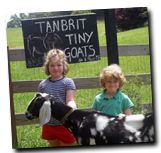
Why test for the caprine G6S mutation?
by Dr. Christine King
What is G6S?
G6S is short for N-acetylglucosamine-6-sulfatase. It's a naturally occurring enzyme that is involved in the normal turnover of glycosaminoglycans (GAGs), which are large protein-sugar molecules that make up the connective tissues throughout the body.
Turnover of molecules and cells is a normal part of healthy tissue maintenance. Think of it like home maintenance and repair: as they wear out, old or damaged GAGs are removed and replaced with new ones. So, G6S is one of the handymen involved in maintaining healthy tissues.
What is the G6S mutation?
The G6S mutation is an inherited defect of the specific gene that directs the production of G6S in cells. In goats with this genetic defect, the normal production of G6S is stopped before it's completed, so G6S is deficient in affected goats.
As a result of this defect, GAGs accumulate in the liver and other tissues. They are particularly problematic in the brain. In fact, in humans with this same defect, the main symptom is severe, progressive mental deterioration.
In other words, the G6S mutation causes a progressive neurodegenerative disease. The first goat known to have died of it was a purebred Nubian who died suddenly at 19 months of age, after having shown delayed motor development (i.e. a delay in learning normal, age-appropriate movement patterns and co-ordination) and retarded growth.
Because the defect causes a slowly progressive accumulation of GAGs, which eventually "gum up the works," the signs of neurological deterioration typically are subtle, slow to worsen, and easily missed or mistaken for something else. In fact, sudden death may be the first sign noticed in affected goats. Unfortunately, it's also the last, so it is well worth breeders doing whatever they can to eradicate this genetic defect from their herds.
How is it passed on?
The G6S mutation in goats seems to be confined to Nubians and their crosses, such as Mini Nubians. It is described as a single, autosomal recessive mutation, which means that it involves only one gene, it is not sex-linked (i.e. it appears in both genders equally), and two copies of the defective gene must be present in order for the animal to be affected.
With the notable exception of the ovum (egg) and sperm, cells contain two strands of genes (DNA), each strand inherited from one parent. So, the buck donates one strand and the doe the other.
Because the G6S mutation is a single, autosomal recessive trait, its inheritance pattern is a relatively simple one. The table below gives the probabilities of passing on the defective gene to the kid with different combinations of gene presence in the parents.
Probabilities of getting normal, carrier, or affected kids from different pairings of bucks and does.

normal = negative for the mutated gene in both strands of DNA; normal animals, unable to pass the defect to their offspring
carrier = only one copy of the gene (i.e. inherited from only one parent); carrier animals appear normal but carry one copy of the gene, which may be passed to their offspring
affected = positive for the mutated gene in both strands of DNA (i.e. inherited a copy of the gene from both parents); affected animals will most likely show signs of the disease as they age
It's important to understand that these are only general probabilities-the chance of a certain outcome with any given breeding. It's never quite as neat as that in real life.
For example, when breeding a normal (-/-) animal to a carrier (-/+), even though the chances of getting a normal kid are 50:50, you might get a string of carrier kids before you get a normal one; and vice versa. In other words, if that particular pairing of buck and doe is repeated 10 times, then approximately 50% of the kids will be normal, but they might be kids 2, 3, 6, 9, and 10 instead of kids 2, 4, 6, 8, and 10.
So, why test for the G6S mutation or buy G6S-negative goats?
There are two good reasons for testing for the G6S mutation in Nubians and Mini Nubians or buying confirmed G6S-negative goats:
1. this genetic mutation compromises the health and shortens the life of affected goats,
2. the defective gene can be identified with a blood test at any age, so it's easy to identify affected and carrier animals and not use them for breeding.
Buying kids or adult goats from a breeder who uses only G6S-negative bucks and does in their breeding program means that you don't need to have those goats tested for the G6S mutation. You're also supporting the eradication of this genetic defect from the breed. If every breeder tested for the G6S mutation and took care to use only G6S-negative animals in their breeding program, this defect could become a thing of the past.
************************************************************************
Copyright © 2013, Christine King. All rights reserved.
About the author: Dr. Christine King is an Australian veterinarian and medical writer, now living and practicing in Winston-Salem, North Carolina.










